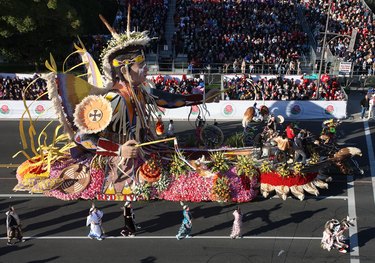
The Tournament of Roses Parade in Pasadena, California, is one of the most widely recognized parades. The floats in the parade are specific to a theme and must be covered in flowers and plant material. Winning an award in the Rose Parade is considered a high honor among float designers and creators. A huge amount of year-round effort goes into these creations that only last for a short time at the beginning of each year.
Design and Theme
Video of the Day
Rose parade floats are highly designed pieces of art. The only purpose of the floats' existence is to dazzle and amaze the crowd who will view it. Intended to stand out among all the other floats with the same goal in mind, the designers must adhere to the theme of the parade, announced by the parade committee in early January. Each float entry may submit two design ideas. Out of approximately 200 entries each year, only about 60 are chosen by the two committees who review and approve the entries. Past themes have included Celebrate Family, Music Music Music, Tall Tales and Around the World in Flowers.
Video of the Day
Framework
The self-propelled chassis is the heart of the construction, but the mechanics should not be visible. Even though it is the most necessary piece, the chassis is ignored when the crowd watches the parade. A chassis can sometimes be salvaged and reused for a new float, depending on the design. All of them are built to support the structures that will eventually be covered in flowers. Framework is built and welded together, and any moving parts are built and tested. Everything is then covered in aluminum wire screen. This is sprayed with polyvinyl plastic liquid, generally in the same color that corresponds with the flowers that will be on that part of the float.
Materials
The chassis consists of support structures of metal, electronics and hydraulics systems. The wire and plastic skin is the frame for the plants and flowers to be attached to. The visible portion of the float must all be made from plant material, with roses of course being part of the design. Seeds, grasses, leaves and bark are also permissible. Not all floats use a large number of roses, but whatever flowers they do use must be ordered months in advance to fill the quantities in color and size needed to cover the float before it rolls out in the parade. Timing is of the essence to ensure the flowers are peaking at the right time. Some floats require up to 10,000 lbs. of flowers.
Time and Money
Float construction begins nearly immediately after the parade is finished. Within days the parade committee announces a new theme, and builders begin the design process. It takes an entire year to construct these amazing pieces of art, with the last week being the most crucial because the fresh flowers cannot be attached too early. Sponsors and groups support the construction, which can reach nearly a half million dollars in costs for some of the more elaborate floats.
Year-Round Process
In early January, the theme is announced and builders begin designing float ideas. By mid-February, the committee approves entries, and the accepted ones can begin refining the details. By March, the finished detailed plan should be complete, and sponsors generally view them for approval. This is also the time that designers shop for new sponsors and gain added funds for the projects. By May, chassis construction begins, and a full-color scale model is built. Upon presentation to the sponsors, final approval is given and building begins in earnest.
Around June, the heavy construction begins. By September, the main structures should be complete and smaller pieces are added and completed. By October, nonperishable items such as seeds, beans or bark can be added, and a scaffold is built to begin the decorating process. The skins are painted with a final coat, and all small areas are painted and completed. Flowers begin arriving in late December and are stored in huge tents until needed. Construction goes into full gear now with flowers being glued to the floats by hundreds of volunteers round the clock. Judging begins on December 30th and is completed on December 31st. On New Year's Eve the floats are towed to the parade staging area for presentation to the world the following day. Within weeks, the process begins all over again.